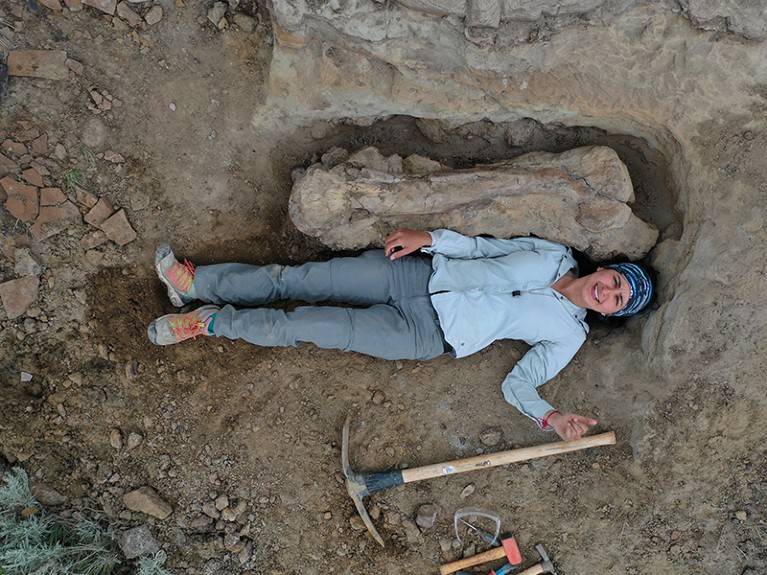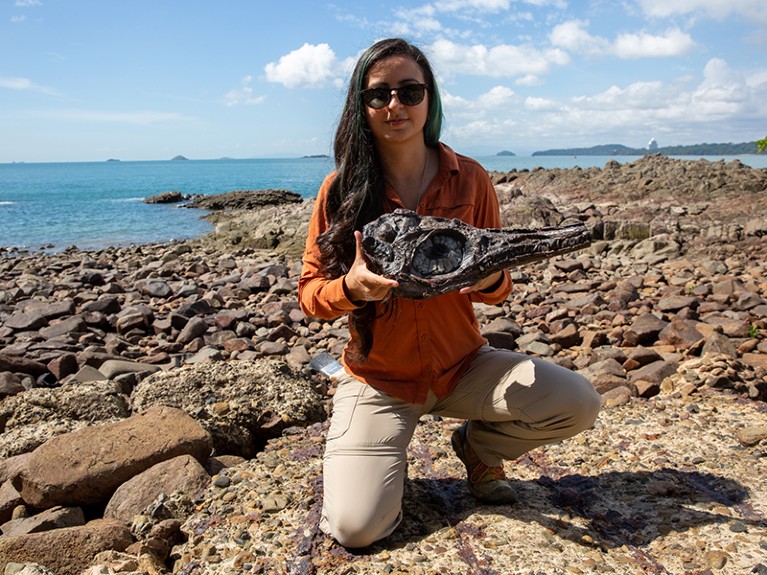
PhD candidate Dirley Cortés lies subsequent to a therapod dinosaur’s lengthy bone throughout a area course on the Dinosaur Provincial Park close to Brooks, Canada.Credit score: Hans Larsson/McGill College, Canada
Born and raised in Villa de Leyva, Colombia, Dirley Cortés used to return dwelling from household walks together with her pockets stuffed with rocks from the fossil-rich space round her small hometown. Her household, stuffed with fossil collectors and preparators, used these rocks to encourage her to maintain asking questions on how the world works.
Now a PhD candidate at McGill College’s Redpath Museum in Montreal, Canada, Cortés investigates the constructions of meals chains in marine ecosystems from the Cretaceous interval. She can also be the scientific director of the Paleontological Analysis Centre in Villa de Leyva, a non-profit establishment that research fossils from the Paja Formation, situated in central Colombia.
Villa de Leyva sits atop the formation, a band of sedimentary rocks that accrued in the course of the Early Cretaceous interval from 130 million to 115 million years in the past, a time when Earth had a hotter local weather, Iguanodon walked on land and enormous marine reptiles, akin to Padillasaurus and Kyhytysuka sachicarum, had been apex predators within the oceans. Cortés tells Nature concerning the challenges that she has confronted as a Latina working in tutorial palaeontology, and the way she has navigated them as an early-career researcher.
What motivated you to change into a scientist?
What units a scientist aside is that they stick to the query, to dig deeper and attempt to discover solutions. In Villa de Leyva, I used to be all the time surrounded by fossils and rocks. Once I bought dwelling with my pockets stuffed with my finds, I used to be curious to know what they had been and the way they got here to be on this place. It was attention-grabbing to learn and be taught that the planet was very completely different a very long time in the past. I learn Journey to the Heart of the Earth by Jules Verne, and that made me much more intrigued and fascinated by the mysteries beneath our ft.
When did your pursuits flip to palaeontology?
In secondary faculty, one in all my academics cherished the concept of me doing a analysis venture in palaeontology. My household had collected the fossilized jaw of a pliosaur, so my finest buddy and I made a decision to attempt to perceive what a pliosaur was — a big, carnivorous marine reptile — by making ready the jaw and exhibiting how we may take away the rock overlaying the bone to know the creature’s anatomy. We additionally constructed a concrete mannequin of a therapod dinosaur and donated it to the college, to spark curiosity among the many college students.

Cortés holds a forged of an ichthyosaur (Muiscasaurus catheti) cranium whereas educating in Panama Metropolis.Credit score: Jorge Alemán/Smithsonian Tropical Analysis Institute, Panama
Your loved ones has lengthy been concerned in palaeontology, however you’re the first to pursue an expert analysis profession within the area. What does that imply to you?
It’s an infinite privilege. It additionally comes with a way of duty. I’ve obtained a lot from Colombia and my hometown — I’ve to provide again not directly. It’s such a wonderful and magical place.
I’ve had the chance to attach with a rising community of palaeontologists, scientists and students in Colombia, and that creates a shared mission. We really feel that it’s essential to advance science within the nation — Colombians want a greater fundamental understanding of science, from primary-school college students to undergraduates and even to professionals, together with these going through the general public, akin to politicians. My colleagues and I are presently working with the native authorities to develop a public-policy programme in palaeontology, to assist this area to flourish within the area.
What challenges have you ever confronted as a Latina palaeontology pupil?
Academia carries many biases. Traditionally, it has been elitist, classist and sexist, and plenty of elements of it nonetheless are. Being a part of a neighborhood of Latin American ladies in science is essential to me. I’ve discovered that doing science is the final word act of riot, and a technique to confront the injustices that ladies face daily.
I believe researchers from a rustic akin to Colombia is perhaps labelled with stereotypes — the Colombian passport all the time carries additional weight, due to the nation’s social and political historical past.
Latina ladies, ladies of color and feminine scientists can generate discomfort in these entrenched in the established order, which is an effective signal as a result of it means we’re breaking glass ceilings. It means we’re filling areas that weren’t meant for girls like us.
I’ve confronted conditions within the area during which ladies are anticipated to prepare dinner or assist in the kitchen, however aren’t requested to drive the automobile or carry heavy issues. To push again, ladies can do the alternative of what they’re anticipated to do — occupy these areas, break down these limitations and rewrite the narratives.
What else can ladies do to navigate these challenges?
The very first thing is to talk up. Understanding that it’s not a battle that falls solely on one particular person, however one which resonates with all of us. Collectively we are able to obtain extra; if one particular person falls, we may also help to raise her up. A very powerful factor has been to create help networks, have interaction in discussions, perceive that there are conditions during which we shouldn’t be submissive and work out learn how to face situations of patriarchy.
It has been essential for me to seek out feminine position fashions. As an example, assembly different Colombian palaeontologists, akin to Mónica Carvalho on the College of Michigan in Ann Arbor and Catalina Pimiento on the Paleontology Institute and Museum on the College of Zurich, Switzerland, has been crucial for me. Their analysis has contributed to our understanding of what tropical forests appeared like in the course of the dinosaurs’ time, and to unravelling the organic historical past of the megalodon (Otodus megalodon) to know when and why it turned extinct. They’ve proven me that ladies can do wonderful issues.
What would you say to different early-career ladies from Latin America beginning on this path?
I’d inform them it’s potential, however provided that they don’t romanticize science they usually actively work to attain social justice in what they do. Doing science comes with an enormous duty, and wherever you might be, you’re breaking limitations. It’s potential, however it’s not simple.
Being a part of networks of girls who work every day to sort out these challenges is essential. Exterior Latin America, we’d seem to be oddities — however our presence challenges patriarchal norms, and that impacts the world exterior our analysis. It shifts the tradition of science to be extra equitable. We’re like little ants fulfilling a much bigger position within the colony. Taking a look at your place that manner may also help you to savour conditions that aren’t snug.
What are your future plans?
For now, the subsequent step is to maintain learning the biota of the Paja Formation and delve deeper into how historical seas and ecosystems functioned and the way that applies to in the present day’s marine ecosystems.
I’m presently in search of postdoc positions. My plan is to find out about new analysis strategies, discover new areas and time scales and ask new questions. I’ll additionally keep related with the Paleontological Analysis Centre and the community of palaeontologists in Colombia and Latin America. My final objective is to maintain contributing to the mission of scientific improvement in Colombia by means of palaeontology and public outreach.
Your article helped me a lot, is there any more related content? Thanks!